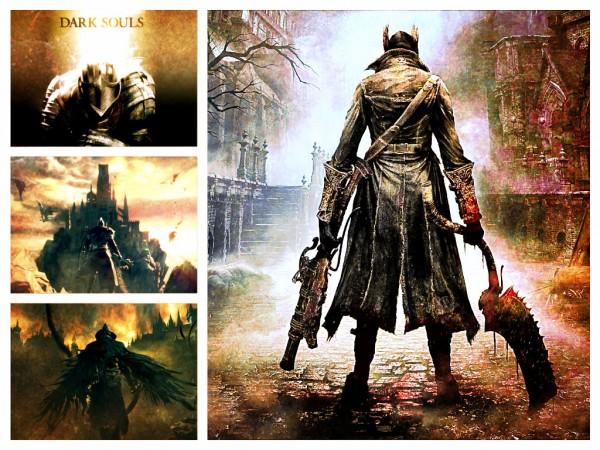
When From Software's PS4 exclusive Bloodborne was announced at the Sony E3 2014 press conference, fans and enthusiasts discussed how this new title is a revamped version of the previously-released Dark Souls.
Even though many think both are the same, there are differences you will come across if you sit with both the titles and compare them side-by-side. Bloodborne somehow feels like a new direction for the folks over at From Software, although certain Dark Souls elements will resurface once in a while.
With Bloodborne already out for PS4, here's a closer look at the differences (and a few similarities) between the game and Dark Souls:
Bloodborne vs Dark Souls: Difficulty Level
Going through first few levels of the game, it seems like the enemies in Bloodborne are a bit easier to deal with than those in Dark Souls. The difference lies in the fact that in Bloodborne, while the usual enemies aren't that tough to crack, the boss fight suddenly builds on the pressure on the player and he/she could realise the significant jump in the difficulty levels. Dark Souls, however, maintains a parallel level of difficulty that doesn't really change throughout the game.
Bloodborne vs Dark Souls: Resistance vs Attack
There are notable differences in the way both the games are approached. We are talking about Dark Souls' defense-minded combat against Bloodborne's offense-minded one. Defence plays a key role in Dark Souls and we have seen that time and again. It doesn't matter as to what kind of a warrior you are (light or heavy-weight), you will always play the game with a defensive approach. Players always remember the "defend before you attack" principle that's involved and accordingly, invest on damage-absorbing shields and learn how to dodge attacks. Bloodborne, however, has an entirely new take on the Regain System; and players, if taken a hit, need to perform an on-the-spot counterattacking move to regain lost health. Players have to precise with their counterattacks and fast-paced if they are to regain lost health in Bloodborne.
Bloodborne Vs Dark Souls: Level Design
From whatever we have seen thus far, Bloodborne seems to offer levels that are more linear in nature. That's a major deviation from the level design that we saw for Dark Souls. Bloodborne, it's safe to say, offers uncomplicated corridors that even hold one or two shortcuts to help you reach the boss fight faster. However, we felt the game could have added elements of hidden and dangerous traps that the users would be cautious about (like in Dark Souls). And while not many will complain, it somehow takes away those maze-like location elements out of the game that were so difficult to decipher, but challenging nonetheless.
Bloodborne vs Dark Souls: Combat Speed/Technique
Another area of difference that stands out between both Dark Souls and Bloodborne is the speed of combat. Whereas Dark Souls approached the game with slower combat techniques, Bloodborne is almost exactly the opposite. There's no place for speed in Dark Souls as you have to carefully take on one enemy at a time. You need to hunt each of them by distracting them away from the herd, and even escaping the location at times to survive. Combat elements in Dark Souls are all about taking it slow and steady, with quite the patience involved, even with normal enemies. Bloodborne, however, offers faster combat elements that require you to strategise even faster. Taking too much time to finish foes off can often be dangerous; hence, both your character and the enemies around comparatively move faster. In fact, the overall gameplay speed in Bloodborne is faster than Dark Souls.
Bloodborne Vs Dark Souls: Multiplayer
The multiplayer aspect of Bloodborne, we believe, will help the game reach higher grounds in the industry. It's absolutely amazing how well the multiplayer for Bloodborne has been executed. It's quite the straightforward approach to things here with players being assisted via Insight (use it to summon help) or Small Beckoning Bell (jump into a stranger's game). Bloodborne also offers a sort of private lobby that allows you to play the game with a particular friend. Dark Souls' multiplayer aspect was anyway a bit intricate and fans were extremely excited to have a private lobby feature in the game.
Bloodborne vs Dark Souls: Weapons
Both the games have extensive numbers of weapons at the player's disposal. As far as Dark Souls is concerned, each weapon has different strengths and weaknesses and players can upgrade them to improve them or add magic abilities. However, despite so many weapons at hand, there's hardly an instance where the player has opted to change his or her weapon midway since changing weapons also force you to change your play-style. Everything depends on the kind of weapon you adapt yourself with at the start of the game, and then sticking with it for the rest of the journey. Bloodborne, however, offers an arsenal of weapons that can be used in multiple forms. This may force the player to learn how to use the weapon, but it's also a great way of keeping things fresh. If you are to excel at Bloodborne and its offense-minded gameplay style, you should know how and when to change weapon forms mid-game to remain one step ahead of your foes.

















